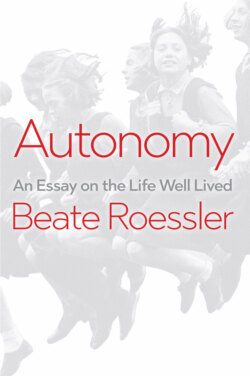Читать книгу Autonomy - Beate Roessler - Страница 22
Conflicts of ambivalence as conflicts of identity
ОглавлениеConflicts of ambivalence arise as conflicts of identity, Amélie Rorty argues, because in the pluralistic cultures and roles in which we live, we are constantly confronted with a “wide variety of modes of life, whose organizing values and perceptual saliences are sometimes incompatible and incommensurable.”38 What is specific to these conflicts of ambivalence in comparison to those discussed above, namely the cases of Agamemnon, George the chemist, Mr R, and the poet or farmer? First, it is not desires or beliefs that are in conflict here but value systems or cultural contexts, cultural and moral frame narratives.
Second, these conflicts do not permit any prioritization (movie vs concert) or any decision in favor of one side or the other (poet or farmer, daughter or army), but only a kind of shifting or switching between the two. People who live with such ambivalent identity conflicts are, as Paul Benson writes, “authentically ambivalent.”39 This is demonstrated by the above-mentioned example of María Lugones, a Latina lesbian who neither can nor wants to choose between different cultures and values. She wants to remain fundamentally ambivalent. This seems the only form of life suitable to her, given how she is socially, culturally, and politically oriented in the world at the moment.40 And this means that she must constantly swing back and forth between the chauvinist culture of her own family and the culture of her lesbian social circle, constantly switch between one identity and the other. I would like to elucidate this form of ambivalent identity conflict once again with the help of a literary example, Siri Hustvedt’s novel The Blazing World. This is another exceedingly complex novel, but one that in any event also illustrates that, in the case of certain profound conflicts of value and identity, it is impossible to prioritize between two conflicting identities. It shows that, even as shifting between identities is necessary, autonomy remains possible.
“All intellectual and artistic endeavors, even jokes, ironies, and parodies, fare better in the mind of the crowd when the crowd knows that somewhere behind the great work or the great spoof it can locate a cock and a pair of balls.”41 This is The Blazing World’s opening salvo, which prefigures the theme of the entire novel. It comes from a letter written by Harriet Burden, the novel’s protagonist, and quoted by the “editor” of her literary estate: her notes, diaries, and letters. Hustvedt’s novel portrays the life of a feminist artist in a patriarchal society in mostly subtle, at times coarse, often intricate, and extremely intelligently constructed ways. Harriet “Harry” Burden is a multimedia artist, the creator of magnificent, large-scale installations in New York, and the wife of an extraordinarily successful art dealer, Felix Lord (one should note the names). She has never had any real success as an artist, however, and so, after the death of her husband, she resorts to a trick. Successively presenting her artworks to the public under the names of three young men, she creates the great breakthrough she had hoped for. Only with the last of the three male artists do things go wrong (because he acts as though the installations are actually his own), but this is in no way the most important aspect of the plot or the novel. The Blazing World plays with a variety of literary forms (academic essays, notebooks, interviews, diaries, stories) from a variety of different perspectives (Harriet Burden, her family, her collaborators, her friends). The narrative form of the novel reflects the fragmented, multifaceted life of its protagonist. Burden writes in her diary about Margaret Cavendish (who is also the source of the novel’s title): “The duchess is a dreamer. Her characters wield their contradictory words like banners. She cannot decide. Polyphony is the only route to understanding. Hermaphroditic polyphony.”42 The sexism of the patriarchal art world forces Burden to mask herself – it forces her into different roles and identities that are incompatible with each other. “The path to truth is doubled, masked,” and to the three works that she plants on the young men she gives the collective title Maskings.43 “We live inside our categories,” she writes, “and we believe in them, but they often get scrambled. The scrambling is what interests me. The mess.”44 And this “mess” of categories, (gender) identities, and value systems can only be endured with fundamental ambivalences.
Hustvedt shows us that Burden feels alienated from the values of the patriarchal art world but at the same time is a loving wife to Felix Lord, one of this world’s most successful representatives, and a loving mother to their children. As a wife, she profits from the world that excludes her as an artist. As an artist she is excluded, but, equipped with her masks, she still endeavors to be successful in this world from this very position. As I mentioned above, Benson calls individuals who live in such identity conflicts “authentically ambivalent.” They “take ownership” of both sides and see themselves as incapable of living any other way. Harriet Burden is fundamentally ambivalent, but she is in no way alienated from her ambivalent self. She wants to be a person for whom there is not yet a place in existing cultural values systems. At the same time, she also wants to be a person who already has a proper place: a recognized feminist artist as well as a glamorous hostess and wife of a brilliant man. She is ambivalent because she cannot reconcile her different roles and identities with each other but instead must switch between them. In this sense, by the way, we can also conceive of this form of ambivalence as a potential source of social criticism, as we can interpret it as a critique of precisely the kinds of conditions that compel individuals to live in such profound ambivalence.
